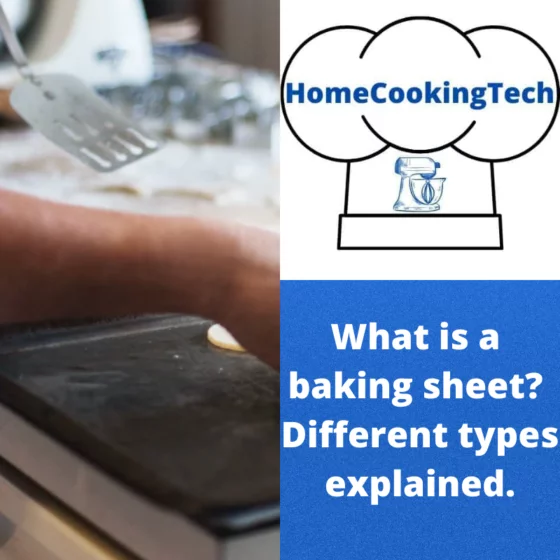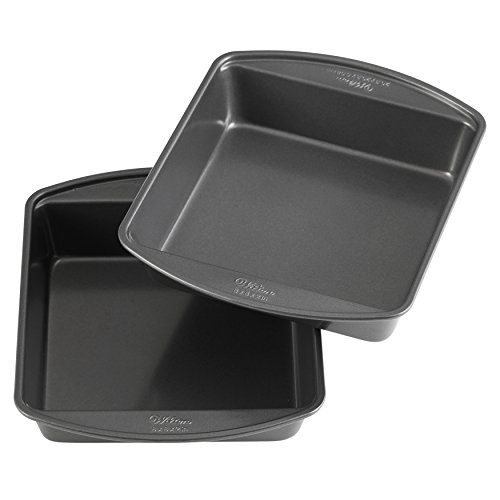Baking sheet, cookie sheet, baking pan, silicone mat, and many other similar-looking but still different carriers that you can use for your baking experiments.
On 1st look, they might appear to be the same, but there are differences that you should consider when choosing the proper baking base.
Take a baking sheet, for example:
A baking sheet is a heat-resistant plate usually made out of metal used for inside oven baking. Baking sheets can be covered with parchment paper, wax paper, or aluminum foil to provide them with non-stick ability.
As I have mentioned at the beginning, many different baking sheets allow for different types of cooking, from roasting to breading to baking.
If you are interested in a general overview of baking take a look at my article here.
Let’s take a deeper dive into all these types of baking plates and see their differences.
How do baking sheets work
Let’s take cookies as an example. A baking sheet works as a carrier or holding plate for the goods that will be baked. You make the dough, make little balls out of it, and place them on the baking sheet with enough space around them to account for the increased volume from baking.
If you don’t do this, all those cookies will melt together into one big mess. Similar to this:
To turn cookie dough into delicious cookies, you need a bit of time, heat from the oven, and heat transference of the baking sheet.
The heat generated by the oven is transferred to the cookies from the top and sides. Another critical side used in the baking process is the bottom, where is the baking sheet located.
This is a simple heat transference mechanism. It ‘soaks up’ the heat into itself and provides it to the goods that are being baked. A significant factor being the surface area of the baking sheet and the temperature of the sheet itself. The larger it is, the better and quicker it will absorb heat, providing it to the goods that are being baked on it.
One of the less known facts is that the baking sheet itself holds a lot of heat. It is not just a conductor but also a keeper and distributor of heat. It is usually around 400°F. To protect your hands from burning, it’s recommended that you use an oven glove or oven mittens whenever you are touching a baking sheet.
A common misconception is that the temperature of the sheet drops down dramatically after switching off the oven.
This is not the case. As mentioned earlier, it keeps the heat for at least a 30minutes, sometimes even longer than that. All this heat transfer information might be a bit confusing, but most important is that there are some rules and guidelines to follow when baking to stay safe and sound.
These are:
- The baking sheet should use metal, not a plastic-based material.
- When you bake your goods, make sure there’s enough room for them to cool. The last thing you want is a burnt goodie.
- When it comes to cookies, there should be enough space between each cookie. If the cookies touch, they will stick together. You want them to look nice right out of the oven.
- It is recommended to preheat the oven for at least 20 minutes before you are going to bake anything. That way, the heat will be absorbed by the baking sheet faster, as it won’t have to ‘wait’ for the oven to get hot.
- When it is time to take your goods out of the oven, have a towel or heat-resistant mittens next to you. This will allow you to grab the hot baking sheet and handle it with ease.
Two most common types and, at the same time, ones that people get most confused about.
The main difference between the two is that cookie sheets do not have margins around them.
The cookie sheets should be a flat plate with a maximum of two tilted sides. This allows you to have more cookies on one cookie sheet and take them off quickly. You slide them off and put on a new batch for baking.
On the other hand, the baking sheet should have margins all around itself. It is easier to use, as you have more options to hold it from different sides. Another significant difference is also connected to the margins of a baking sheet. They allow you to bake taller goods, like cakes.
It doesn’t mean that you cannot bake cookies on a baking sheet. You definitely can and most likely already did. The main thing is the fact that it can be much easier to use a cookie sheet for them.
The lack of sides on cookie sheets allows you to use them for cookies mostly; pizza is also an option. But most other things like cake will slide off, as there is nothing to hold it in place.
To better explain the differences described above, let me show you pictures of a baking sheet and cookie sheet.
Baking sheet in all of its glory
As you can see all of its margins are tilted upwards to keep all contents inside.
A cookie sheet for comparison
The cookie sheet on the other hand has its space wide open, so you can fit more cookies on.
The baking sheet, cookie sheet, and most common bakeware for that matter can withstand the same amount of heat up to 500°F (260°C), which is plenty enough for any standard oven and recipe you decide to make.
Now, what about the other two, you might ask, well let’s take a look, shall we?
Baking pan vs. silicone mat
Both can provide the same function but are different in their design.
A baking pan is usually much deeper than a baking sheet. This is caused mainly by its margin. It is much higher, allowing for baking way more significant volumes. You can make a thick layer of brownies, which is excellent if you have a big family or enjoy tall cakes.
On the other hand, the silicone mats are much thinner than baking or cookie sheets and are also much cheaper. They consist of a polyurethane compound. You place them directly on your oven rack. The silicone is an insulator, so it will not burn on contact with the metal oven rack.
The silicone mat has no margin at all. The silicone mats are usually used as a non-stick layer on top of your baking sheet, cookie sheet, or baking pan. But you can use them for baking as well.
I would not recommend it, as it can get wobbly and fiddly. If there is no other option than put your dough in the middle, carefully transfer it to the oven and check on it occasionally.
Again to convey the differences better, here are pictures to tell 1000 words.
A baking pan is the king of volume baking.
Another contestant to show off in our little club, a silicone mat.
Baking sheet materials
At a 1st glance, all of these bakeware pieces might look like they are made out of the same materials with different colors, but this is not the case.
These days you can get your baking sheets made out of almost any imaginable material. But I would recommend keeping with some metal.
I have a much deeper article about different materials here, but I will list the few most common ones to keep this short for now.
Stainless steel
Stainless steel baking sheets are a great choice if you do not want to spend too much money. You can find them in every kitchenware shop for a meager cost. They are durable, have non-stick properties, which is most important for baking.
Get your own stainless steel baking sheet on Amazon.
Alloy Steel
Alloy steel baking sheets are a great choice if you want to spend some money. They are slightly more expensive than the stainless steel ones but provide an even better non-stick surface.
Get your own alloy steel baking sheet on Amazon.
Cast Iron
Cast iron baking sheets are a perfect choice if you want to invest in your bakeware. They have the best non-stick properties of all materials. Sometimes they get dirty pretty quickly, but it is easy to clean, and they last forever.
Get your own cast iron baking pan on Amazon.
Aluminum
Aluminum baking sheets are a great option if you want to go with metal but do not want to compromise quality. An aluminum baking sheet is a perfect choice for people who are not big fans of non-stick metal like stainless steel.
Aluminum is a great conductor of heat and is famous for its non-stick properties. It is the most durable of all the metal baking sheets, but it has a downer – it does not have any non-stick properties.
Get your own aluminum baking sheet on Amazon.
Porcelain
On the other hand, a porcelain baking sheet offers excellent non-stick properties at a price that would make you frown. Baking sheets made of porcelain will most likely cost more than those made of stainless steel or aluminum. But you have high-quality bakeware that will last you a lifetime if you care for it.
Get your own porcelain baking pan on Amazon.
Silicone
Silicone baking sheets are becoming more and more popular these days. They have all of the baking sheet features, but they come with a non-stick silicone layer on them. This makes cleaning very simple as everything will slide right off.
They are super light and straightforward to store. They can withstand high temperatures, so making cakes and cookies is an effortless task for them. The main downer is that they are not dishwasher safe.
Get your own silicone baking mat on Amazon.
Cleaning bakeware
The best way to clean most baking sheets is to go with warm water and a little soap. This works for both metal and non-stick coatings. It is essential not to put the baking sheets in the dishwasher.
Bakeware with non-stick coating needs to be cleaned with dedicated cleaning agents. It makes the non-stick properties last much longer. In most cases, you can go with warm water and soap for washing your bakeware.
A more extensive article on cleaning your bakeware can be found here.
So this is it, the introduction to what a baking sheet is.
If you are interested in a general overview of knowledge and skills for home cooks, check out my article here.
I hope you have a much clearer vision of it now.
If you have any additional questions, please do let me know in the comments below.
Until next time I wish you fabulous baking.
























